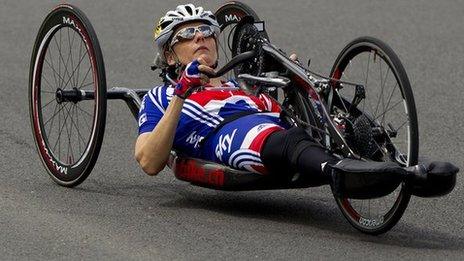Archery at the Rio 2016 Paralympics: All you need to know
- Published
Paralympic Games on the BBC |
|---|
Venue: Rio de Janeiro, Brazil Dates: 7-18 September Time in Rio: BST -4 |
Coverage: Follow on Radio 5 live and via live text commentary. |

"Armless archer" Matt Stutzman was born without arms but shoots using his feet - he won silver at the individual compound event at London 2012
How does it work?
In Paralympic archery, archers compete in two classes - Open and W1 and there are two bows used, compound and recurve.
Targets have a diameter of 122cm and Open Recurve competitors shoot from a distance of 70m while Open Compound and W1 competitors shoot from 50m.
The target is marked with 10 concentric rings which increase in points value the smaller and the closer they get to the centre. A hit in the outermost zone is worth one point while a hit in the centre, the 'gold', is worth 10 points.
Each event includes a ranking round where each archer shoots 72 arrows (12 ends of six arrows each) before the archers enter the elimination rounds.
The winner in the elimination phase in the Open Compound and W1 events is the athlete who scores the most points across the five ends of three arrows in each head-to-head match. In the Open Recurve event, the winner is the first archer to score to six points with two points given to the one who gets the highest score over each end of three arrows.
In the event of a tie, an arrow-by-arrow shoot-off will be held, creating the possibility of a gold medal being decided by a single shot.
There are six competitions in Rio for individual competitors and in some events the top performers in the ranking round will receive a bye in the first elimination round, because of the number of entries.
For the three team events, teams are ranked according to the combined scores from the ranking round before proceeding to the knock-out stages.
Competitors in the open category may have an impairment in their legs and use a wheelchair or may also have a balance impairment and shoot standing or resting on a stool. They may shoot in recurve or compound competitions under standard rules.
Competitors in the W1 category may have an impairment in their legs and use a wheelchair. They may shoot either a recurve or compound bow modified from standard rules but there are not separate competitions for the two disciplines.
The recurve bow is the more traditional style of bow - when the string is drawn back, the curves of the bow straighten to give leverage when it is released - while the compound bow uses a system of levers and pulleys in order to fire the arrows.
Who are the British medal hopes?
Reigning compound champion Danielle Brown was deemed ineligible for Paralympic competition in late 2013 and is unable to defend her title while silver medallist Mel Clarke also failed to make the team.
The main ParalympicsGB hopes will be in the compound W1 competition where John Walker and Jo Frith both won individual silver and team gold at the 2015 World Championships and went on to win the European team title earlier this year.
Frith will face a tough challenge from GB team-mates Jess Stretton, who is just 16, and Vicky Jenkins.
Who are the other challengers?
China, Korea and Russia are traditional powerhouses in the sport. China were top of the medal table at last year's World Championships in Germany.
Did you know?
American Matt Stutzman was born without arms but shoots using his feet - earning the nickname the "Armless Archer". He won silver at the Individual compound event at London 2012.
ParalympicsGB London 2012 medals
Two (one gold, one silver).
- Published23 August 2016

- Published5 September 2016
